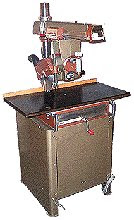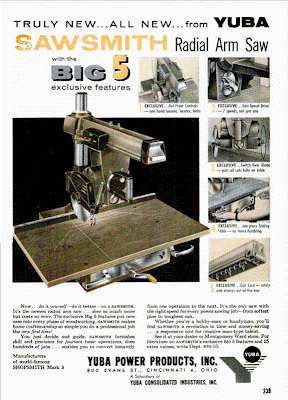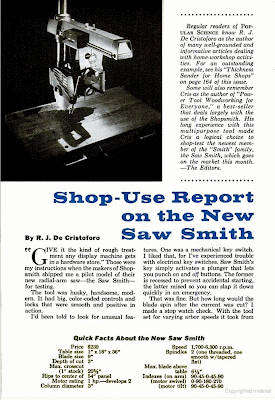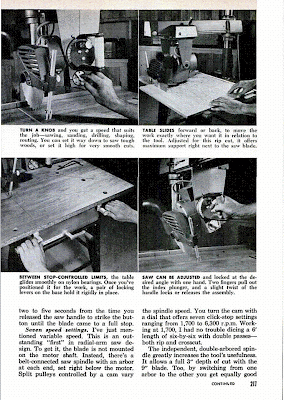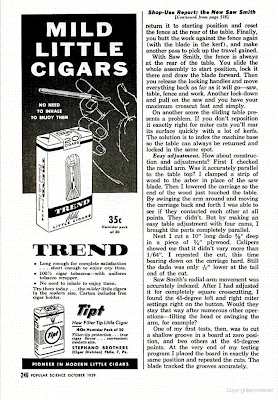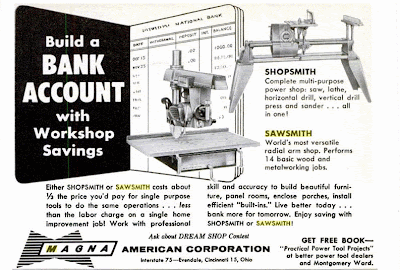I just received an email from someone who found this blog and who was just given a SawSmith Radial Arm Saw. One thing stumped him, and now that I've answered his question I realize that it would make for a great blog post. So without further adieu, here's his question and my answer. Feel free to improve upon it in the comment section.
A few months ago I helped a friend move several hundred miles away. In return for my help, she offered me any tool from a pretty large selection. One/third of this 3-car garage was full of her ex's power tools. His health is failing rapidly and will never use them again. I spied this SawSmith and couldn't take my eyes off it. Cool!! I can add this tool to my woodworking hobby tool inventory.
I loaded it in my trailer and hauled it to my place. I gave it a temporary home in the garage. I need to clean up an area in my workshop to accommodate this tool. I was looking to see what voltage was required and found a plate on the GE motor saying operating voltage was 115/230. It has a plug on it that is shaped with the prongs in normal positions except one is turned sideways. A friend told me that this indicates that it must be plugged in to a 115/120 receptacle with a 15 amp or higher service output. Then, another friend told me it's wired for a 230/240 circuit. I'm confused, to say the least. If it's wired for 120V, I don't want to plug it in to a 240V circuit or vice versa. I have 120V outlets with a dual configuration on the same outlet. One that would accept a normal double vertical plug or one as I described, with one vertical and one horizontal prong and the third (ground) prong, making a sideways T. ( -l l )
How can I tell which it is actually wired for? Also, I was searching thru your blogs concerning owner's manuals. I don't see how to acquire one. I checked the plate on the tool frame and found it's a model 703000. I have no idea what that indicates. I see you're talking about Mark I to Mark V machines. How can I tell what it is? I can also clearly read the serial number if that helps. Not knowing if it's a Mark I or Mark V or anything in between, I would have no way of knowing what manual I'd need. I'm sure that model number tells it all.
I'm about ready to get it up and running but need to replace the power cord. I believe I'd use a 14/3 wire for it. But, then again, I may need 12/3. I don't yet know which to use. I'll need to more closely examine the existing cord. I'm really looking forward to using this awesome machine.
Having read that you are a former employee of the company that made this tool, I figured you were the best person to contact for information about it. Any help you can give would be greatly appreciated.
My Answer:
Your friend who said that the plug "
indicates that it must be plugged in to a 115/120 receptacle with a 15 amp or higher service" is the winner! Ideally tools with large motors like this should be plugged into a dedicated receptacle; meaning no other electrical device is on the same circuit. Whenever you see this type of receptacle installed you can be assured that it is 110v and is connected to at least a 15 amp breaker or fuse.
You can get an owners manual from Shopsmith by calling their customer service department at 1(800)762-7555. Say "Hi" to Linda from me.
Your saw is simply know as the "SawSmith Radial Arm Saw". The Mark I, II, V, and VII were lathe-based tools and have nothing in common with the SawSmith except that they were made by the same manufacture and could be used to power the same accessories. (On second thought, that's quite a bit to have in common!)
You'll also find a lot of information and comradery at the SawSmith Yahoo group located at this link:
http://groups.yahoo.com/group/sawsmith/ There's not much going on during the Summer on this group, but things pick-up as the weather cools off a bit and everyone starts heading into their shops. Once you join you'll have access to a bunch of files, including some things called "service bulletins" which were distributed to SawSmith dealers back in the 50's and 60's. There's a wealth of information there, and you'll want to start there if you saw fails to start once you get it wired.
One last thing. Visit
www.patentplaceusa.com and search "SawSmith", and get yourself a copy of the patent for the Sawsmith. It's fascinating and reveals a number of secrets that aren't clear in the manual.
Good luck and I'll see you in the forum.
